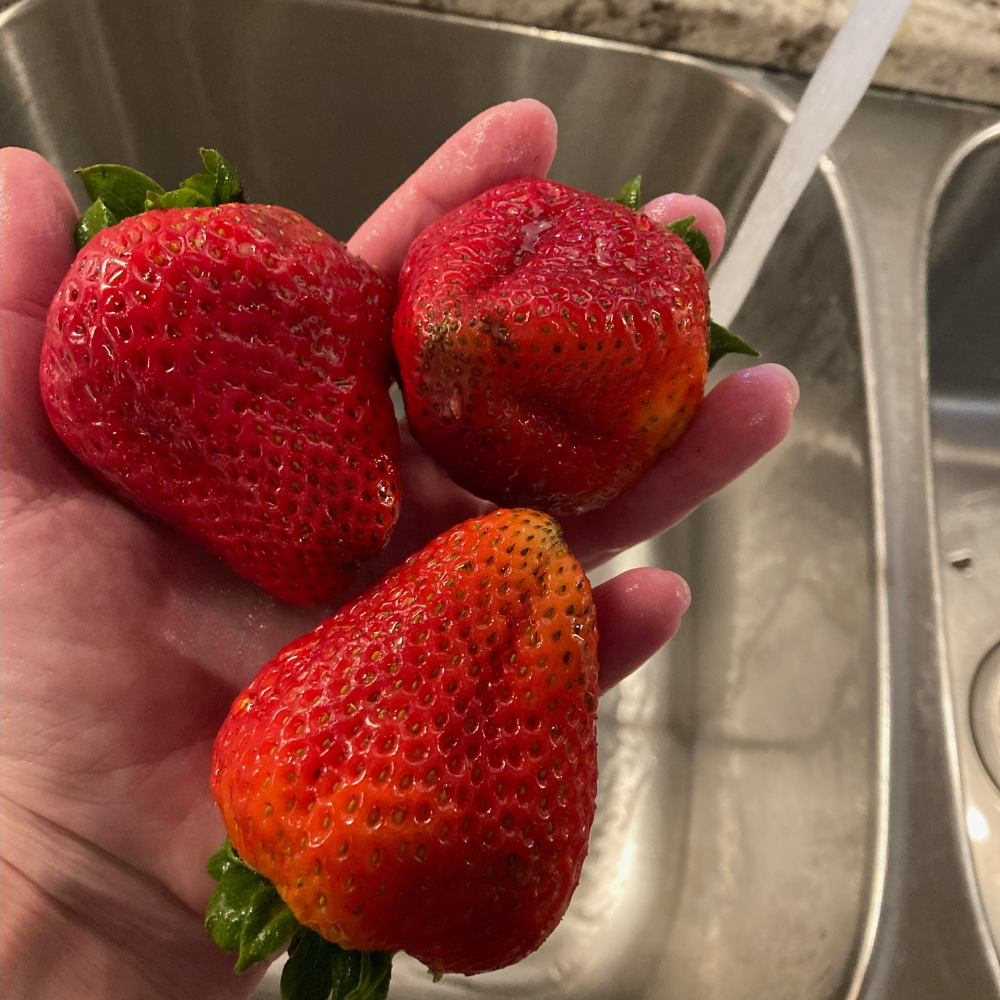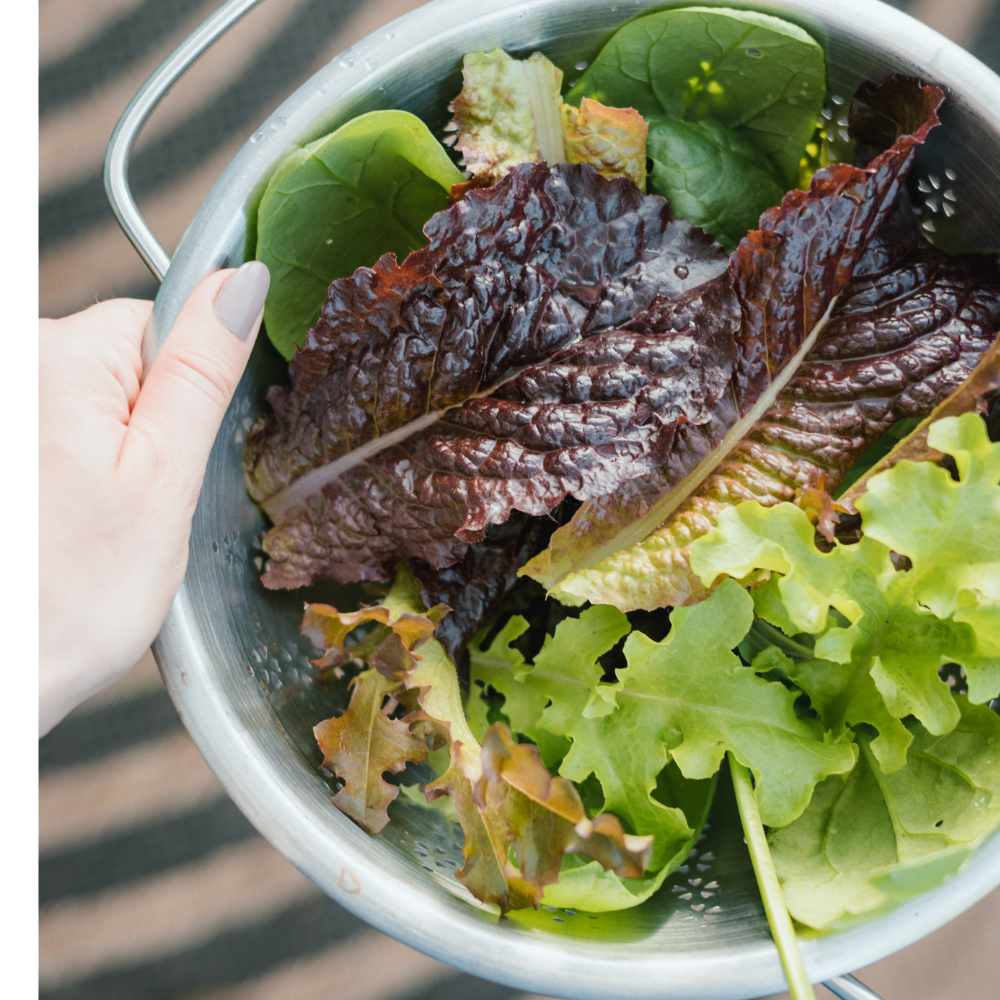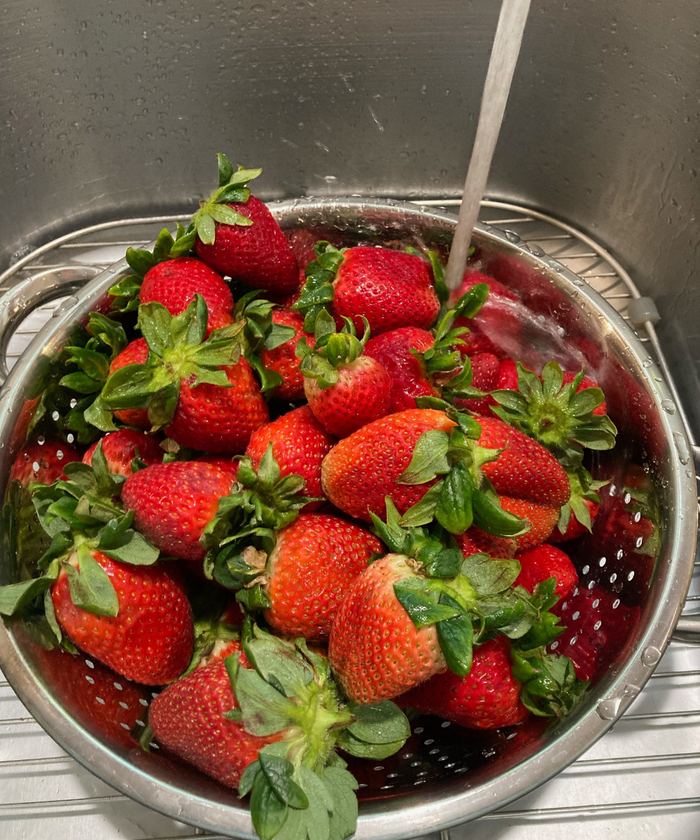You may have heard that you should always wash your produce before consuming it, but do you know why? Washing your produce is about more than just cleaning off the dirt. It can also keep you and your family safe from harmful germa and chemical contaminants. Let’s dive into the world of "clean" eating and explore the benefits of properly washed produce, and understand why washing produce is essential.
In this comprehensive guide, we’ll uncover the importance of cleaning produce, discuss different techniques for various types of fruit and vegetables, share expert recommendations, and delve into the impact of unwashed produce on health. So, are you ready to unlock the secrets of clean eating and maximize the health benefits of your fruit and vegetables by learning why it is crucial to wash produce EVERY time?
Key Takeaways
- Washing fresh produce is essential to avoid contamination and safeguard food safety.
- Properly washing, drying, and special considerations are necessary for different types of fruit and vegetables to ensure they are clean before consumption.
- Unwashed produce can lead to food poisoning or illnesses as well as consumption of chemical sprays.
The Importance of Washing Fresh Produce

We hear a lot about safe food handling around raw foods, especially raw meat, but just as important, washing fresh produce is crucial for preventing contamination and ensuring food safety at home.
When you eat fruits and vegetables without properly washing, you risk ingesting harmful bacteria, pesticides, and other contaminants that could lead to foodborne illnesses. By taking the time to wash your produce, you can effectively eliminate dirt, debris, and bacteria, reducung the risk pesticide ingestion and food borne illnesses due to bacterial contamination.
Food safety experts emphasize the importance of washing all produce, even those labeled as “pre-washed” or “ready-to-eat”. They also recommend drying produce with a clean cloth or paper towel to remove excess moisture, which can help prevent bacterial growth.
Individuals with weakened immune systems should take additional precautions to ensure their safety when handling and consuming fresh produce, to avoid foodborne illness.
The Dirty Dozen
The Dirty Dozen is a term coined by the Environmental Working Group (EWG) to identify the 12 fruit and vegetables that are most likely to be contaminated with pesticide residues.
According to the EWG, these foods, when conventionally grown (as opposed to organically), contain more pesticides than other produce items. The list is updated annually and typically includes:
- strawberries
- spinach
- kale
- nectarines
- apples
- grapes
- peaches
- cherries
- pears
- tomatoes
- celery
- potatoes
These foods have thin skins that do not offer much of a barrier to pesticides. They are also high on the list because they are often eaten raw, which means they do not go through a cooking process that can kill off bacteria or break down pesticides. Therefore, it is particularly important to wash these fruits and vegetables thoroughly to reduce bacteria and other lingering debris before consumption.
Contaminated Produce and Disease Control
Contaminated food, including contaminated produce, is a major concern when it comes to disease control. Unwashed fruits and vegetables can harbor harmful bacteria, leading to food poisoning and disease outbreaks.
- Salmonella - Salmonella is a type of bacteria that can contaminate fresh produce, leading to salmonellosis, an infection that affects the intestinal tract. Symptoms can include diarrhea, fever, and abdominal cramps, which usually develop 12 to 72 hours after infection and can last for 4 to 7 days.
- E. coli - E. coli, or Escherichia coli, is a type of bacteria that can contaminate fresh produce, leading to infections in the digestive tract. While some strains are harmless, others can cause severe illness. Symptoms of an E. coli infection can include severe abdominal cramps, diarrhea (often bloody), vomiting, and in some cases, a mild fever. Symptoms usually appear 3 to 4 days after exposure, but can begin anywhere from 1 to 10 days after consuming contaminated food.
- Norovirus - Norovirus is a highly contagious virus that can contaminate fresh produce. It causes gastroenteritis, an inflammation of the stomach and intestines. Symptoms include nausea, vomiting, diarrhea, and stomach cramping. Some people may also experience fever, headache, and body aches. Symptoms usually begin 12 to 48 hours after exposure and last for 1 to 3 days.
- Campylobacter - Campylobacter jejuni is a bacterium that can contaminate fresh produce, leading to campylobacteriosis, an infection in the digestive tract. Symptoms of a Campylobacter infection can include diarrhea (often bloody), fever, abdominal pain, nausea, headache, and muscle pain. Symptoms usually appear 2 to 5 days after exposure and can last for up to a week.
- Listeria monocytogenes - Listeria monocytogenes is a type of bacterium that can contaminate fresh produce, leading to listeriosis, a serious infection primarily affecting pregnant women, newborns, older adults, and individuals with weakened immune systems. Symptoms of a Listeria infection can include fever, muscle aches, nausea, and diarrhea. Severe cases can lead to headache, stiff neck, confusion, loss of balance, and convulsions.
- Clostridium perfringens - Clostridium perfringens is a type of bacteria that can contaminate fresh produce, leading to a foodborne illness known as perfringens food poisoning. Symptoms of a Clostridium perfringens infection can include severe abdominal cramps and diarrhea. Symptoms usually begin 6 to 24 hours after consuming contaminated food and can last for 24 hours to 2 days.
Fresh produce has been linked to outbreaks of foodborne illnesses when not properly washed. The following outbreaks were reported by the Centers for Disease Control (CDC) (Centers for Disease Control and Prevention. (August 10, 2023). Outbreaks of Foodborne Illness. https://www.cdc.gov/foodsafety/outbreaks/lists/outbreaks-list.html).
Recent Outbreaks
- Leafy Greens - Listeria outbreak in 2023, affecting 16 states, with 19 reported illnesses and 18 hospitalizations
- Organic Strawberries - hepatitis outbreak in 2022, affecting 4 states, with 19 cases and 13 hospitalizations
- Packaged salad mix- E. coli outbreak in 2022, affecting 4 states, with 10 cases, 4 hospitalizations and 1 death.
- Packaged salad mix - Listeria outbreak in 2022, affecting 13 states, with 18 illnesses, 16 hospitalizations and 3 deaths.
- Fresh Peaches - Salmonella outbreak in 2020, affecting 17 states, with 101 reported cases, and 28 hospitalizations
Large Outbreaks
- Cantaloupe - Listeria outbreak in 2012, affecting 28 states, with 147 cases, 143 hospitalizations and 33 deaths
- Cucumber - Salmonella outbreak 2015, affecting 40 states, with 907 cases, 204 hospitalizations and 6 deaths
- Fresh Spinach - E. coli outbreak in 2006, affecting 26 states, with 199 cases, 102 hospitalizations and 3 deaths.
Pesticide residues
Most produce growers use some form of herbicide or pesticide treatment to protect their crops. Common chemicals used in growing produce, identified by the Environmental Protection Agency (EPA) (U.S. Environmental Protection Agency, August 9, 2023, https://www.epa.gov/ingredients-used-pesticide-products), include:
- 2,4-D - 2,4-Dichlorophenoxyacetic acid (2,4-D) is a common herbicide used in the agricultural industry to control weeds. It is known for its ability to mimic the plant hormone auxin, causing uncontrolled growth and eventual death in broadleaf weeds (Duke, S. O., & Powles, S. B., 2008).
- Glyphosate - Glyphosate is a widely used herbicide that controls broadleaf plants and grasses. It has been used in agricultural and residential settings for over four decades. Glyphosate works by inhibiting a specific enzyme pathway required for plant growth. While it is effective in controlling unwanted vegetation, there are ongoing debates about its potential impacts on human health and the environment (Duke, S. O., Powles, S. B., 2008).
- Methomyl - Methomyl is a potent insecticide and rodenticide widely used in agriculture. It belongs to the carbamate class of pesticides and works by inhibiting the activity of an enzyme called acetylcholinesterase, which is essential for the normal functioning of the nervous system in insects. Methomyl is highly effective against a broad spectrum of pests, but it is also highly toxic to humans and wildlife, making proper handling and application essential (National Pesticide Information Center, 2020).
- Sulfoxaflor - Sulfoxaflor is an insecticide that is used to control sap-feeding insects, such as aphids and whiteflies. It belongs to the class of sulfoximines, a group of compounds that disrupt the normal functioning of the nervous system in insects, leading to their death. Sulfoxaflor is known for its effectiveness against pests that have developed resistance to other insecticides (Sparks, T. C., Watson, G. B., Loso, M. R., Geng, C., Babcock, J. M., & Thomas, J. D., 2013).
Approximately 70% of fruits and vegetables in the United States contain pesticide residue, even after washing. To ensure the safety and quality of your produce, make sure to wash it thoroughly before consuming.
The CDC and FDA both recommend washing produce before eating or cooking it to ensure food safety and reduce potential health risks. By thoroughly washing your fruits and vegetables, you can enjoy their full nutritional value and maximize their health benefits.
Techniques for Washing Different Types of Produce

Washing fruits and vegetables, requires specific techniques tailored to different types of fruits and vegetables. Specific washing techniques can effectively remove contaminants, ensuring that your produce is clean and safe to eat.
Firm Produce
Firm produce, such as apples, carrots, and potatoes, requires a thorough scrub before eating, to remove dirt, bacteria, and other contaminants. The most effective methods for cleaning firm fruits and vegetables include:
- Swishing them in a bowl of cool water
- Scrubbing with a clean vegetable brush
- Soaking in a vinegar solution
- Rubbing under running water with your hands
Taking time to properly wash firm produce not only lowers the risk of foodborne illnesses but also ensures you reap the full nutritional benefits of these healthful raw foods.
Delicate Produce
Delicate produce refers to fruits and vegetables with thin skin or those that are easily bruised, such as berries, herbs, and tomatoes. Washing delicate produce requires a gentle touch to avoid damaging the skin and causing spoilage.
An effective approach for washing delicate produce involves using cool water and a sink sprayer or colander, gently cleaning soft items like berries, herbs, and tomatoes. Avoid using abrasive scrub brushes or detergents, as they can damage the delicate skin of the produce and potentially introduce more contaminants.
Leafy Greens

Leafy greens, such as lettuce, spinach, and kale, are particularly susceptible to contamination due to their structure, which can trap dirt and bacteria. The recommended washing method for leafy greens involves soaking them in a bowl of water and gently agitating them to remove dirt and bacteria.
Leafy greens require proper drying techniques, as excess moisture can foster bacterial growth. Pat them dry with a clean towel or use a salad spinner to remove excess moisture before storing them in a clean container or bag in the refrigerator.
Expert Recommendations for Washing Produce
Experts, including the FDA, recommend using cool water to wash fruits and vegetables, proper drying techniques, and taking special precautions for those with weakeer immune systems. Following these guidelines can help ensure that your fruits and vegetables are clean, safe, and ready for consumption.
Effectiveness of Produce Washing Solutions
Produce washing solutions, often marketed for washing fruits and vegetables, are designed to clean fresh foods more effectively than water alone. These solutions, which typically contain natural ingredients such as citrus, vinegar, or other plant-based compounds, are intended to remove dirt, bacteria, and pesticides from the surface of fresh fruits and vegetables. While these washes can enhance cleanliness, it's important to note that they may not always be necessary. Research has shown that a thorough rinse with cool, running water can be just as effective at removing contaminants. However, for those who prefer an extra layer of cleanliness, a produce washing solution can be beneficial.
Using Vinegar to Wash Produce
Vinegar is a natural and effective way to clean fruits and vegetables. It has been proven to be particularly effective in removing bacteria and pesticide residues from fruits and vegetables. To use vinegar for washing, create a solution with one part vinegar to three parts water. Soak in this solution for a few minutes, then rinse with cold water. Studies have shown that this method can remove up to 98% of bacteria from your food, making it a highly effective, natural, and cost-effective solution for cleaning fruits and vegetables before consumption.
Proper Drying Techniques
Properly drying your produce after washing is a key step to prevent bacterial growth. Using a clean cloth towel, paper towel, or salad spinner is recommended for drying greens. Proper drying techniques can also help maintain the texture and quality of your fruits and vegetables, making them more enjoyable to eat.
Special Considerations for Weakened Immune Systems
Individuals with weakened immune systems should take extra care when washing fresh vegetables and fruits to minimize the risk of illness. This includes:
- Using large amounts of cold or warm tap water
- Scrubbing with a clean vegetable brush when appropriate
- Avoiding the use of soap, detergent, bleach solutions, or commercial washes.
Additionally, it’s crucial to wash your hands with warm, soapy water for at least 20 seconds before and after handling fresh fruits and veggies to further reduce the risk of contamination.
By taking these precautions, those with weaker immune systems can enjoy the benefits of fresh fruits and vegetables without compromising their health.
Summary
Throughout this comprehensive guide, we’ve explored the importance of washing fresh produce, the techniques for cleaning different types of fruits and vegetables, expert recommendations, and the impact of unwashed fruits and vegetables on health. By understanding the risks associated with consuming unwashed foods and the benefits of properly washing fruits and vegetables, you can make informed decisions about your food preparation habits and enjoy the full nutritional potential of your food.
Remember, clean eating starts with clean food. So, the next time you reach for a fresh apple, give it a thorough wash and enjoy the peace of mind knowing that you’re not only nourishing your body but also protecting yourself from harmful contaminants.
Frequently Asked Questions
Is produce washing necessary?
Washing fresh foods is necessary to remove bacteria that could cause illness. Even if your greens are pre-packaged and "triple washed", always wash it before consuming.
How effective is washing produce?
Washing fresh fruits and vegetables under running water is an effective way to reduce the number of microorganisms, removing up to 90-99% of bacteria. Additionally, using a vinegar solution (one part vinegar, three parts water) has been shown to reliably remove 98% of bacteria from fruits and vegetables.
Is it important to wash all produce before you store it?
It is not necessary to wash when you bring it home, as this can lead to bacteria growth and a shorter shelf life. Store unwashed fruits and vegetables until you're ready to eat them.
How should I wash delicate foods like berries and herbs?
Gently clean delicate foods such as berries and herbs with cool water and a sink sprayer or colander to avoid damaging the skin.
What are the potential risks of consuming unwashed produce?
Consuming unwashed produce can lead to food poisoning, foodborne illnesses, and reduced health benefits.

